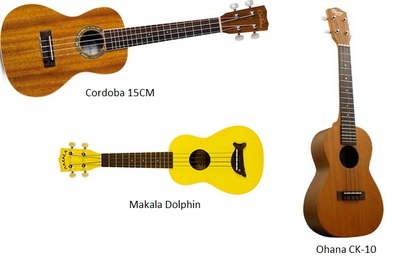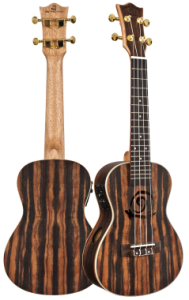Classroom Ukulele Recommendations

Since the popularity of the ukulele has returned, manufacturers of all stripes have gone out of their way to capitalize on the demand for the instruments. As music teachers, we see all sorts of poorly-made instruments come into our classrooms and studios, and know how discouraging it can be for a student to not be able to sound good on their instrument.
Besides...if you're purchasing a classroom set, YOU have to listen to them!
Ukuleles CAN be much cheaper than their bigger, six-string cousin, but that does not mean that any cheap ukulele will work well for your classroom! (See this rant on cheap ukuleles.) When I first purchased 4 ukuleles for my classroom to supplement my guitar class, I went with a popular beginning brand. Within 2 years, they were not holding up well. In contrast, the Cordoba ukuleles that comprise my full classroom set of 30 have been used almost daily by middle school students for 4 years now, and most of them look new, and sound great!
We also need to be careful to reinforce the idea that the ukulele is a legitimate instrument, and not a toy. Consider carefully whether the pretty-colored "fun" ukuleles are really going to be the best choice - will it cause your class to abuse them in a way that they would not with a "legit" instrument? Will the lack of seriousness implied by the colors make them more approachable, or cause the students to abuse them? That's a question only you can answer - you know your kids.
I personally prefer concert-sized instruments for the classroom. They're a nice balance of sound with good projection and a comfortable size for most students, regardless of age. My own 7-year-old plays a concert-sized ukulele with no problems, along with his 11-year-old sister and myself, their *cough* -year-old father!
Recommended Models for Classroom Instruments:
The following brands and models are ones that I have personal experience with, but are by no means the only decent instruments. When possible, try to play a few different models before deciding! You're a musician, regardless if you play ukulele already. You'll know the difference between a good-sounding instrument and not.
In order of preference & cost. The cost I am listing is a ballpark price based on purchasing a larger number of instruments (20+), and intended only as a guideline. Your cost may vary according to the vendor, number of instruments you purchase, and area:
The sound of a ukulele is heavily influenced by the strings. Take a look at my String Comparison Page for a demonstration of how much of a difference it can make, as well as ideas on saving money in your budget!
Besides...if you're purchasing a classroom set, YOU have to listen to them!
Ukuleles CAN be much cheaper than their bigger, six-string cousin, but that does not mean that any cheap ukulele will work well for your classroom! (See this rant on cheap ukuleles.) When I first purchased 4 ukuleles for my classroom to supplement my guitar class, I went with a popular beginning brand. Within 2 years, they were not holding up well. In contrast, the Cordoba ukuleles that comprise my full classroom set of 30 have been used almost daily by middle school students for 4 years now, and most of them look new, and sound great!
We also need to be careful to reinforce the idea that the ukulele is a legitimate instrument, and not a toy. Consider carefully whether the pretty-colored "fun" ukuleles are really going to be the best choice - will it cause your class to abuse them in a way that they would not with a "legit" instrument? Will the lack of seriousness implied by the colors make them more approachable, or cause the students to abuse them? That's a question only you can answer - you know your kids.
I personally prefer concert-sized instruments for the classroom. They're a nice balance of sound with good projection and a comfortable size for most students, regardless of age. My own 7-year-old plays a concert-sized ukulele with no problems, along with his 11-year-old sister and myself, their *cough* -year-old father!
Recommended Models for Classroom Instruments:
The following brands and models are ones that I have personal experience with, but are by no means the only decent instruments. When possible, try to play a few different models before deciding! You're a musician, regardless if you play ukulele already. You'll know the difference between a good-sounding instrument and not.
In order of preference & cost. The cost I am listing is a ballpark price based on purchasing a larger number of instruments (20+), and intended only as a guideline. Your cost may vary according to the vendor, number of instruments you purchase, and area:
- Cordoba 15-CM (Approx. $70 per instrument)
- Ohana CK-10 (Approx. $50 per instrument)
- Kala 15-S (Approx. $50 per instrument)
- Makala Dolphin (Soprano Size Only - Approx. $30 per instrument)
The sound of a ukulele is heavily influenced by the strings. Take a look at my String Comparison Page for a demonstration of how much of a difference it can make, as well as ideas on saving money in your budget!
Teacher Instrument & Equipment Recommendations
But don't forget about you! Again, I highly recommend that you go to your local music store and try out as many instruments as you can. You'll find an immense number of web pages that will make recommendations on makes and models of instruments for players, and I won't try to duplicate those. However, I will recommend getting an acoustic/electric instrument, or adding a pickup after you purchase one!
Why? Well, so the students can hear your instrument; either as a demonstration of what they are going to play, or so that you can accompany them while they play. Your plugged-in ukulele can even double as a metronome if you tap the bridge while it's plugged in!
Of course, I'm listing the equipment below as an "ideal world" setup. It may be that you have to build this up over a couple of years, or you are able to purchase it all at once. As far as the specific makes & models of the ukuleles below, these are instruments that I have personally used over the years, and continue to use. They of course aren't the only good ones out there. (Of course, that means that the instruments below are sizes I tend to use myself, so choose the sound and feel you like the best.)
Why? Well, so the students can hear your instrument; either as a demonstration of what they are going to play, or so that you can accompany them while they play. Your plugged-in ukulele can even double as a metronome if you tap the bridge while it's plugged in!
Of course, I'm listing the equipment below as an "ideal world" setup. It may be that you have to build this up over a couple of years, or you are able to purchase it all at once. As far as the specific makes & models of the ukuleles below, these are instruments that I have personally used over the years, and continue to use. They of course aren't the only good ones out there. (Of course, that means that the instruments below are sizes I tend to use myself, so choose the sound and feel you like the best.)
Concert Size Recommendations

Snail Electric Ebony with EQ & Tuner, Approx. $250
I normally play a tenor sized ukulele, but during a time that my tenor was in for repairs, I stopped in at a local music shop and came across this beauty. I was smitten, and it's still one of my favorite to play. The tuner is built into the electronics, which is handy in the classroom. Besides the snail-shaped soundhole on the front, there is also a sound port on the side, which allows you to more clearly hear your instrument's sound. Plus, it will look VERY different from the students' instruments, making it easier to distinguish it from theirs.
Besides...just look at it!
Snail ukuleles are made by Antonio Violins/Amahi Ukuleles in Ohio. I've been very impressed by all of the instruments I've heard from this company.
I normally play a tenor sized ukulele, but during a time that my tenor was in for repairs, I stopped in at a local music shop and came across this beauty. I was smitten, and it's still one of my favorite to play. The tuner is built into the electronics, which is handy in the classroom. Besides the snail-shaped soundhole on the front, there is also a sound port on the side, which allows you to more clearly hear your instrument's sound. Plus, it will look VERY different from the students' instruments, making it easier to distinguish it from theirs.
Besides...just look at it!
Snail ukuleles are made by Antonio Violins/Amahi Ukuleles in Ohio. I've been very impressed by all of the instruments I've heard from this company.
Tenor Size Recommendations
Acoustic Only?
|
What if you didn't get an acoustic/electric or can't find one you like, but still want to be able to plug in to an amplifier in the classroom?
Of course, when you purchase a ukulele, you want it to sound the best when it's acoustic, and any time you purchase an acoustic/electric, you are paying a premium for the pickup. Sometimes it's worth it, but then sometimes, it's not! Besides, it's not terribly difficult to put a pickup into a ukulele if you want to make it electric after the fact. Last Winter Break, my 7-year-old and 11-year old were going to do a ukulele trio with myself for Christmas, and we needed to amplify all of us in order to be heard in the space we were performing, so I ended up making their ukuleles electric for less than $5 a piece. (See Tips & Tricks for information on how to do that!) All it takes is a $1 door alarm from a dollar store, an $3 input jack, a couple of wires, hot glue, and some minor soldering, and you've gone electric! |
|

